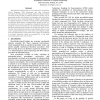Free Online Productivity Tools
i2Speak
i2Symbol
i2OCR
iTex2Img
iWeb2Print
iWeb2Shot
i2Type
iPdf2Split
iPdf2Merge
i2Bopomofo
i2Arabic
i2Style
i2Image
i2PDF
iLatex2Rtf
Sci2ools
DATE
2005
IEEE
2005
IEEE
Design of Fault-Tolerant and Dynamically-Reconfigurable Microfluidic Biochips
Technology Roadmap for Semiconductors (ITRS) clearly identifies the integration of electrochemical and electrobiological techniques as one of the system-level design challenges that will be faced beyond 2009, when feature sizes shrink below 50nm [5]. Microfluidics-based biochips are soon expected to revolutionize clinical diagnosis, DNA sequencing, and other laboratory procedures involving molecular biology. Most microfluidic biochips are based on the principle of continuous fluid flow and they rely on permanently-etched microchannels, micropumps, and microvalves. We focus here on the automated design of “digital” droplet-based microfluidic biochips. In contrast to continuous-flow systems, digital microfluidics offers dynamic reconfigurability; groups of cells in a microfluidics array can be reconfigured to change their functionality during the concurrent execution of a set of bioassays. We present a simulated annealing-based technique for module placement in such biochips. The pla...
DATE 2005 | Digital Microfluidics-based Biochips | Hardware | Microfluidic Biochips | Microfluidics-based Biochips |
| Added | 24 Jun 2010 |
| Updated | 24 Jun 2010 |
| Type | Conference |
| Year | 2005 |
| Where | DATE |
| Authors | Fei Su, Krishnendu Chakrabarty |
Comments (0)

